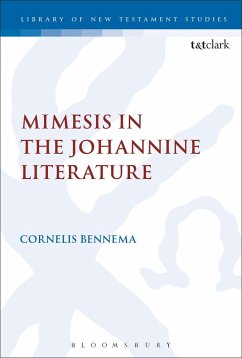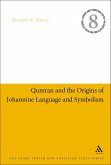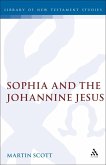28,95 €
28,95 €
inkl. MwSt.
Sofort per Download lieferbar

14 °P sammeln
28,95 €
Als Download kaufen

28,95 €
inkl. MwSt.
Sofort per Download lieferbar

14 °P sammeln
Jetzt verschenken
Alle Infos zum eBook verschenken
28,95 €
inkl. MwSt.
Sofort per Download lieferbar
Alle Infos zum eBook verschenken

14 °P sammeln
- Format: PDF
- Merkliste
- Auf die Merkliste
- Bewerten Bewerten
- Teilen
- Produkt teilen
- Produkterinnerung
- Produkterinnerung

Bitte loggen Sie sich zunächst in Ihr Kundenkonto ein oder registrieren Sie sich bei
bücher.de, um das eBook-Abo tolino select nutzen zu können.
Hier können Sie sich einloggen
Hier können Sie sich einloggen
Sie sind bereits eingeloggt. Klicken Sie auf 2. tolino select Abo, um fortzufahren.

Bitte loggen Sie sich zunächst in Ihr Kundenkonto ein oder registrieren Sie sich bei bücher.de, um das eBook-Abo tolino select nutzen zu können.
Mimesis is a fundamental and pervasive human concept, but has attracted little attention from Johannine scholarship. This is unsurprising, since Johannine ethics, of which mimesis is a part, has only recently become a fruitful area of research. Bennema contends that scholars have not yet identified the centre of Johannine ethics, admittedly due to the fact that mimesis is not immediately evident in the Johannine text because the usual terminology for mimesis is missing. This volume is the first organized study on the concept of mimesis in the Johannine literature. The aim of the study is to…mehr
- Geräte: PC
- mit Kopierschutz
- eBook Hilfe
- Größe: 1.71MB
Andere Kunden interessierten sich auch für
![The Danielic Eschatological Hour in the Johannine Literature (eBook, PDF) The Danielic Eschatological Hour in the Johannine Literature (eBook, PDF)]() Stefanos MihaliosThe Danielic Eschatological Hour in the Johannine Literature (eBook, PDF)31,95 €
Stefanos MihaliosThe Danielic Eschatological Hour in the Johannine Literature (eBook, PDF)31,95 €![Qumran and the Origins of Johannine Language and Symbolism (eBook, PDF) Qumran and the Origins of Johannine Language and Symbolism (eBook, PDF)]() Elizabeth W. MburuQumran and the Origins of Johannine Language and Symbolism (eBook, PDF)28,95 €
Elizabeth W. MburuQumran and the Origins of Johannine Language and Symbolism (eBook, PDF)28,95 €![An Introduction to the Johannine Gospel and Letters (eBook, PDF) An Introduction to the Johannine Gospel and Letters (eBook, PDF)]() Jan Van Der WattAn Introduction to the Johannine Gospel and Letters (eBook, PDF)24,95 €
Jan Van Der WattAn Introduction to the Johannine Gospel and Letters (eBook, PDF)24,95 €![The Lazarus Story within the Johannine Tradition (eBook, PDF) The Lazarus Story within the Johannine Tradition (eBook, PDF)]() Wendy E. S. NorthThe Lazarus Story within the Johannine Tradition (eBook, PDF)157,95 €
Wendy E. S. NorthThe Lazarus Story within the Johannine Tradition (eBook, PDF)157,95 €![Sophia and the Johannine Jesus (eBook, PDF) Sophia and the Johannine Jesus (eBook, PDF)]() Martin ScottSophia and the Johannine Jesus (eBook, PDF)149,95 €
Martin ScottSophia and the Johannine Jesus (eBook, PDF)149,95 €![The Book of Revelation and the Johannine Apocalyptic Tradition (eBook, PDF) The Book of Revelation and the Johannine Apocalyptic Tradition (eBook, PDF)]() John M. CourtThe Book of Revelation and the Johannine Apocalyptic Tradition (eBook, PDF)141,95 €
John M. CourtThe Book of Revelation and the Johannine Apocalyptic Tradition (eBook, PDF)141,95 €![Text, Context and the Johannine Community (eBook, PDF) Text, Context and the Johannine Community (eBook, PDF)]() David A. LambText, Context and the Johannine Community (eBook, PDF)31,95 €
David A. LambText, Context and the Johannine Community (eBook, PDF)31,95 €-
-
-
Mimesis is a fundamental and pervasive human concept, but has attracted little attention from Johannine scholarship. This is unsurprising, since Johannine ethics, of which mimesis is a part, has only recently become a fruitful area of research. Bennema contends that scholars have not yet identified the centre of Johannine ethics, admittedly due to the fact that mimesis is not immediately evident in the Johannine text because the usual terminology for mimesis is missing. This volume is the first organized study on the concept of mimesis in the Johannine literature. The aim of the study is to establish that mimesis is a genuine Johannine concept, to explain its particulars and to show that mimesis is integral to Johannine ethics. Bennema argues that Johannine mimesis is a cognitive, creative process that shapes the believer's identity and behaviour within the context of the divine family. Besides being instrumental in people's moral transformation, mimesis is also a vital mechanism for mediating the divine reality to people
Produktdetails
- Produktdetails
- Verlag: Bloomsbury eBooks UK
- Seitenzahl: 192
- Erscheinungstermin: 21. September 2017
- Englisch
- ISBN-13: 9780567225702
- Artikelnr.: 48866334
- Verlag: Bloomsbury eBooks UK
- Seitenzahl: 192
- Erscheinungstermin: 21. September 2017
- Englisch
- ISBN-13: 9780567225702
- Artikelnr.: 48866334
- Herstellerkennzeichnung Die Herstellerinformationen sind derzeit nicht verfügbar.
Cornelis Bennema is Senior Lecturer in New Testament at Union School of Theology, UK. He is the author of The Power of Saving Wisdom: An Investigation of Spirit and Wisdom in Relation to the Soteriology of the Fourth Gospel (Mohr Siebeck, 2002), A Theory of Character in New Testament Narrative (Fortress, 2014) and Encountering Jesus: Character Studies in the Gospel of John, 2nd edn (Fortress, 2014).
Preface
List of Abbreviations
1. Introduction
1.1. Outlining the Current State of Affairs
1.1.1. ?? ????There Were OnlyNon-Johannine Studies on Mimesis (1960s)
1.1.2. The Dark Era: There Is No Johannine Ethics (1970-2000)
1.1.3. The Quest for Johannine Ethics (2000-2012)
1.1.4. A New Era of Johannine Ethics (2012-present)
1.1.5. Contemporary Non-Johannine Studies on Mimesis (1970-present)
1.2. Articulating the Problem
1.3. Defining Mimesis
1.4. Formulating Our Aim, Plan and Approach
2. The Johannine Mimetic Language
2.1. Mimesis, Analogy and Reciprocity
2.2. Mimetic Expressions in the Johannine Literature
2.3. Statistical Analysis of the Data
2.4. Conclusion
3. Divine Mimesis
3.1. The Son-Father Mimesis
3.1.1. The Son-Father Relationship
3.1.2. The Paradigm of the Son-Father Mimesis
3.1.3. Specific Occurrences of the Son-Father Mimesis
3.1.4 The Mechanics and Nature of the Son-Father Mimesis
3.2. The Spirit-Jesus Mimesis
3.3. Conclusion
4. Believer-Jesus/God Mimesis
4.1. Conceptual Traces of Mimesis
4.1.1. Following Jesus
4.1.2. Remaining with Jesus
4.1.3. Filial Mimesis
4.1.4. Conclusion
4.2. The Footwashing - Cloning or Creative Articulation?
4.2.1. The Mimetic Model in John 13
4.2.2. Johannine Mimesis as Cloning and Creative Articulation
4.2.3. Conclusion
4.3. Actualizing the Love Command through Mimesis
4.3.1. The Giving of the Love Command (John 13:34-35)
4.3.2. Abiding and Supreme Love (John 15:9-17)
4.3.3. Love in Action (1 John 3:11-18)
4.3.4. God's Love Compels (1 John 4:7-21)
4.3.5. The Scope of the Recipients of the Love Command (and Other Forms of
Mimesis)
4.3.6. Conclusion
4.4. Existential Mimesis
4.4.1. Existential Mimesis in John 17
Excursus: The Johannine Language of 'Oneness' and 'Indwelling'
4.4.2. Existential Mimesis in 1 John 3-4
4.4.3. Conclusion
4.5. Other Instances of the Believer-Jesus Mimesis
4.6. Conclusion
5. The Place of Mimesis in Johannine Ethics
5.1. The Ethical Nature of the Johannine Literature
5.1.1. A Moral Narrative World
5.1.2. A Moral God
5.1.3. Moral Transformation
5.1.4. Conclusion
5.2. Family as the Context of Johannine Ethics
5.2.1. Family Membership and Identity Formation
5.2.2. Family Behaviour and Identity Shaping
5.2.3. Conclusion
5.3. Mimesis as Family Ethics
5.3.1. Mimesis as Family Behaviour
5.3.2. Mimesis and Family Identity
5.3.3. Conclusion
5.4. The Place of Mimesis in Johannine Ethics
5.4.1. The Statistical Argument
5.4.2. The Argument from the Nature of the Divine-Human Relationship
5.5. Conclusion
6. Mimetic Empowerment
6.1. Relational Empowerment
6.2. Mnemonic Empowerment
6.3. The Spirit as Empowerment
6.3.1. The Spirit as a Moral Agent
6.3.2. The Spirit as a Relational Agent
6.3.3. The Spirit as a Mnemonic Agent
6.4. Conclusion
7. Conclusion
7.1. Summary
7.2. The Place of Johannine Mimesis in Antiquity
7.3. Implications
7.3.1. Johannine Ethics as Dynamic, Creative, Spirit-Led Community Ethics
7.3.2. Moral Education and (Trans)formation
7.4. Recommendations for Further Research
Appendix 1: Occurrences of Mimesis in the Johannine Literature
Bibliography
Index of Authors
List of Abbreviations
1. Introduction
1.1. Outlining the Current State of Affairs
1.1.1. ?? ????There Were OnlyNon-Johannine Studies on Mimesis (1960s)
1.1.2. The Dark Era: There Is No Johannine Ethics (1970-2000)
1.1.3. The Quest for Johannine Ethics (2000-2012)
1.1.4. A New Era of Johannine Ethics (2012-present)
1.1.5. Contemporary Non-Johannine Studies on Mimesis (1970-present)
1.2. Articulating the Problem
1.3. Defining Mimesis
1.4. Formulating Our Aim, Plan and Approach
2. The Johannine Mimetic Language
2.1. Mimesis, Analogy and Reciprocity
2.2. Mimetic Expressions in the Johannine Literature
2.3. Statistical Analysis of the Data
2.4. Conclusion
3. Divine Mimesis
3.1. The Son-Father Mimesis
3.1.1. The Son-Father Relationship
3.1.2. The Paradigm of the Son-Father Mimesis
3.1.3. Specific Occurrences of the Son-Father Mimesis
3.1.4 The Mechanics and Nature of the Son-Father Mimesis
3.2. The Spirit-Jesus Mimesis
3.3. Conclusion
4. Believer-Jesus/God Mimesis
4.1. Conceptual Traces of Mimesis
4.1.1. Following Jesus
4.1.2. Remaining with Jesus
4.1.3. Filial Mimesis
4.1.4. Conclusion
4.2. The Footwashing - Cloning or Creative Articulation?
4.2.1. The Mimetic Model in John 13
4.2.2. Johannine Mimesis as Cloning and Creative Articulation
4.2.3. Conclusion
4.3. Actualizing the Love Command through Mimesis
4.3.1. The Giving of the Love Command (John 13:34-35)
4.3.2. Abiding and Supreme Love (John 15:9-17)
4.3.3. Love in Action (1 John 3:11-18)
4.3.4. God's Love Compels (1 John 4:7-21)
4.3.5. The Scope of the Recipients of the Love Command (and Other Forms of
Mimesis)
4.3.6. Conclusion
4.4. Existential Mimesis
4.4.1. Existential Mimesis in John 17
Excursus: The Johannine Language of 'Oneness' and 'Indwelling'
4.4.2. Existential Mimesis in 1 John 3-4
4.4.3. Conclusion
4.5. Other Instances of the Believer-Jesus Mimesis
4.6. Conclusion
5. The Place of Mimesis in Johannine Ethics
5.1. The Ethical Nature of the Johannine Literature
5.1.1. A Moral Narrative World
5.1.2. A Moral God
5.1.3. Moral Transformation
5.1.4. Conclusion
5.2. Family as the Context of Johannine Ethics
5.2.1. Family Membership and Identity Formation
5.2.2. Family Behaviour and Identity Shaping
5.2.3. Conclusion
5.3. Mimesis as Family Ethics
5.3.1. Mimesis as Family Behaviour
5.3.2. Mimesis and Family Identity
5.3.3. Conclusion
5.4. The Place of Mimesis in Johannine Ethics
5.4.1. The Statistical Argument
5.4.2. The Argument from the Nature of the Divine-Human Relationship
5.5. Conclusion
6. Mimetic Empowerment
6.1. Relational Empowerment
6.2. Mnemonic Empowerment
6.3. The Spirit as Empowerment
6.3.1. The Spirit as a Moral Agent
6.3.2. The Spirit as a Relational Agent
6.3.3. The Spirit as a Mnemonic Agent
6.4. Conclusion
7. Conclusion
7.1. Summary
7.2. The Place of Johannine Mimesis in Antiquity
7.3. Implications
7.3.1. Johannine Ethics as Dynamic, Creative, Spirit-Led Community Ethics
7.3.2. Moral Education and (Trans)formation
7.4. Recommendations for Further Research
Appendix 1: Occurrences of Mimesis in the Johannine Literature
Bibliography
Index of Authors
Preface
List of Abbreviations
1. Introduction
1.1. Outlining the Current State of Affairs
1.1.1. ?? ????There Were OnlyNon-Johannine Studies on Mimesis (1960s)
1.1.2. The Dark Era: There Is No Johannine Ethics (1970-2000)
1.1.3. The Quest for Johannine Ethics (2000-2012)
1.1.4. A New Era of Johannine Ethics (2012-present)
1.1.5. Contemporary Non-Johannine Studies on Mimesis (1970-present)
1.2. Articulating the Problem
1.3. Defining Mimesis
1.4. Formulating Our Aim, Plan and Approach
2. The Johannine Mimetic Language
2.1. Mimesis, Analogy and Reciprocity
2.2. Mimetic Expressions in the Johannine Literature
2.3. Statistical Analysis of the Data
2.4. Conclusion
3. Divine Mimesis
3.1. The Son-Father Mimesis
3.1.1. The Son-Father Relationship
3.1.2. The Paradigm of the Son-Father Mimesis
3.1.3. Specific Occurrences of the Son-Father Mimesis
3.1.4 The Mechanics and Nature of the Son-Father Mimesis
3.2. The Spirit-Jesus Mimesis
3.3. Conclusion
4. Believer-Jesus/God Mimesis
4.1. Conceptual Traces of Mimesis
4.1.1. Following Jesus
4.1.2. Remaining with Jesus
4.1.3. Filial Mimesis
4.1.4. Conclusion
4.2. The Footwashing - Cloning or Creative Articulation?
4.2.1. The Mimetic Model in John 13
4.2.2. Johannine Mimesis as Cloning and Creative Articulation
4.2.3. Conclusion
4.3. Actualizing the Love Command through Mimesis
4.3.1. The Giving of the Love Command (John 13:34-35)
4.3.2. Abiding and Supreme Love (John 15:9-17)
4.3.3. Love in Action (1 John 3:11-18)
4.3.4. God's Love Compels (1 John 4:7-21)
4.3.5. The Scope of the Recipients of the Love Command (and Other Forms of
Mimesis)
4.3.6. Conclusion
4.4. Existential Mimesis
4.4.1. Existential Mimesis in John 17
Excursus: The Johannine Language of 'Oneness' and 'Indwelling'
4.4.2. Existential Mimesis in 1 John 3-4
4.4.3. Conclusion
4.5. Other Instances of the Believer-Jesus Mimesis
4.6. Conclusion
5. The Place of Mimesis in Johannine Ethics
5.1. The Ethical Nature of the Johannine Literature
5.1.1. A Moral Narrative World
5.1.2. A Moral God
5.1.3. Moral Transformation
5.1.4. Conclusion
5.2. Family as the Context of Johannine Ethics
5.2.1. Family Membership and Identity Formation
5.2.2. Family Behaviour and Identity Shaping
5.2.3. Conclusion
5.3. Mimesis as Family Ethics
5.3.1. Mimesis as Family Behaviour
5.3.2. Mimesis and Family Identity
5.3.3. Conclusion
5.4. The Place of Mimesis in Johannine Ethics
5.4.1. The Statistical Argument
5.4.2. The Argument from the Nature of the Divine-Human Relationship
5.5. Conclusion
6. Mimetic Empowerment
6.1. Relational Empowerment
6.2. Mnemonic Empowerment
6.3. The Spirit as Empowerment
6.3.1. The Spirit as a Moral Agent
6.3.2. The Spirit as a Relational Agent
6.3.3. The Spirit as a Mnemonic Agent
6.4. Conclusion
7. Conclusion
7.1. Summary
7.2. The Place of Johannine Mimesis in Antiquity
7.3. Implications
7.3.1. Johannine Ethics as Dynamic, Creative, Spirit-Led Community Ethics
7.3.2. Moral Education and (Trans)formation
7.4. Recommendations for Further Research
Appendix 1: Occurrences of Mimesis in the Johannine Literature
Bibliography
Index of Authors
List of Abbreviations
1. Introduction
1.1. Outlining the Current State of Affairs
1.1.1. ?? ????There Were OnlyNon-Johannine Studies on Mimesis (1960s)
1.1.2. The Dark Era: There Is No Johannine Ethics (1970-2000)
1.1.3. The Quest for Johannine Ethics (2000-2012)
1.1.4. A New Era of Johannine Ethics (2012-present)
1.1.5. Contemporary Non-Johannine Studies on Mimesis (1970-present)
1.2. Articulating the Problem
1.3. Defining Mimesis
1.4. Formulating Our Aim, Plan and Approach
2. The Johannine Mimetic Language
2.1. Mimesis, Analogy and Reciprocity
2.2. Mimetic Expressions in the Johannine Literature
2.3. Statistical Analysis of the Data
2.4. Conclusion
3. Divine Mimesis
3.1. The Son-Father Mimesis
3.1.1. The Son-Father Relationship
3.1.2. The Paradigm of the Son-Father Mimesis
3.1.3. Specific Occurrences of the Son-Father Mimesis
3.1.4 The Mechanics and Nature of the Son-Father Mimesis
3.2. The Spirit-Jesus Mimesis
3.3. Conclusion
4. Believer-Jesus/God Mimesis
4.1. Conceptual Traces of Mimesis
4.1.1. Following Jesus
4.1.2. Remaining with Jesus
4.1.3. Filial Mimesis
4.1.4. Conclusion
4.2. The Footwashing - Cloning or Creative Articulation?
4.2.1. The Mimetic Model in John 13
4.2.2. Johannine Mimesis as Cloning and Creative Articulation
4.2.3. Conclusion
4.3. Actualizing the Love Command through Mimesis
4.3.1. The Giving of the Love Command (John 13:34-35)
4.3.2. Abiding and Supreme Love (John 15:9-17)
4.3.3. Love in Action (1 John 3:11-18)
4.3.4. God's Love Compels (1 John 4:7-21)
4.3.5. The Scope of the Recipients of the Love Command (and Other Forms of
Mimesis)
4.3.6. Conclusion
4.4. Existential Mimesis
4.4.1. Existential Mimesis in John 17
Excursus: The Johannine Language of 'Oneness' and 'Indwelling'
4.4.2. Existential Mimesis in 1 John 3-4
4.4.3. Conclusion
4.5. Other Instances of the Believer-Jesus Mimesis
4.6. Conclusion
5. The Place of Mimesis in Johannine Ethics
5.1. The Ethical Nature of the Johannine Literature
5.1.1. A Moral Narrative World
5.1.2. A Moral God
5.1.3. Moral Transformation
5.1.4. Conclusion
5.2. Family as the Context of Johannine Ethics
5.2.1. Family Membership and Identity Formation
5.2.2. Family Behaviour and Identity Shaping
5.2.3. Conclusion
5.3. Mimesis as Family Ethics
5.3.1. Mimesis as Family Behaviour
5.3.2. Mimesis and Family Identity
5.3.3. Conclusion
5.4. The Place of Mimesis in Johannine Ethics
5.4.1. The Statistical Argument
5.4.2. The Argument from the Nature of the Divine-Human Relationship
5.5. Conclusion
6. Mimetic Empowerment
6.1. Relational Empowerment
6.2. Mnemonic Empowerment
6.3. The Spirit as Empowerment
6.3.1. The Spirit as a Moral Agent
6.3.2. The Spirit as a Relational Agent
6.3.3. The Spirit as a Mnemonic Agent
6.4. Conclusion
7. Conclusion
7.1. Summary
7.2. The Place of Johannine Mimesis in Antiquity
7.3. Implications
7.3.1. Johannine Ethics as Dynamic, Creative, Spirit-Led Community Ethics
7.3.2. Moral Education and (Trans)formation
7.4. Recommendations for Further Research
Appendix 1: Occurrences of Mimesis in the Johannine Literature
Bibliography
Index of Authors







